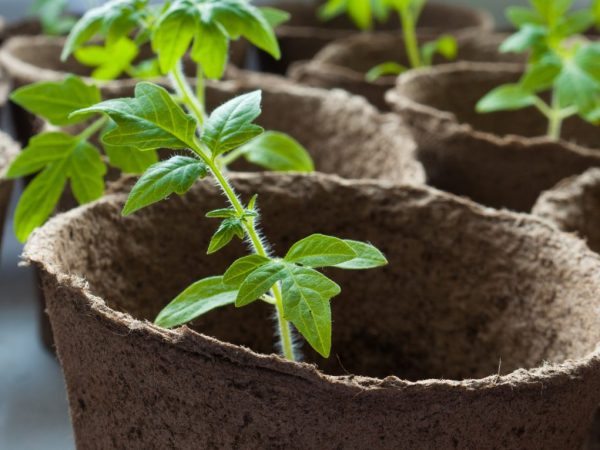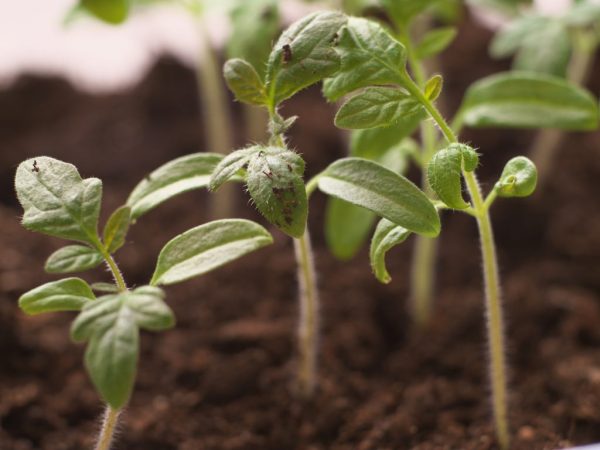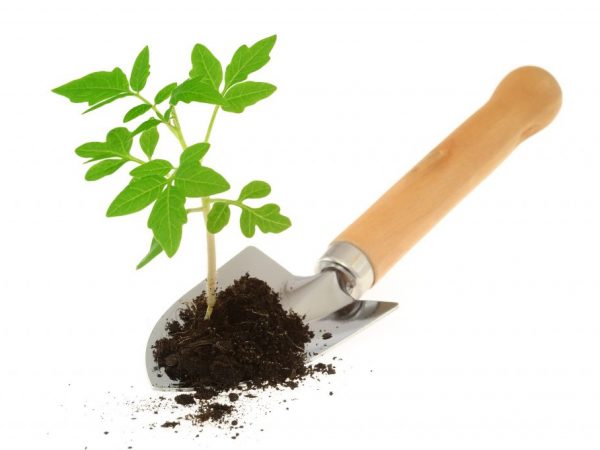Rules for growing tomato seedlings for a greenhouse
It is not always possible to grow early vegetables in the domestic climate. In order for the fruits to ripen on the plant, polycarbonate or film structures are needed. What does a gardener need to know in order for tomato seedlings for a greenhouse to develop without problems? Let's take a closer look at the most important stages of tomato cultivation.

Rules for growing tomato seedlings for a greenhouse
Sowing seedlings
To grow a sturdy vegetable plant, you need to plant the seeds correctly. Bushes for indoor structures must be healthy, which will allow them to grow without problems when the temperature or light falls. The harvest depends on how all the requirements are met.
Preparatory procedures
The first step is to decide on the seed. Not every variety is suitable for indoor cultivation, so it is necessary to find the appropriate mark on the label. Such plants can easily withstand insufficient lighting with increased humidity.
Before planting, the seeds are soaked in a fungicide, then in a growth activator ("Epin", "Zircon"), after which they are left in a damp napkin for germination. Professional hybrids do not need these procedures. Most often, the raw materials have already been subjected to pelleting, covering the material with a protective and nutritious shell. In this case, work is carried out directly in a container with soil.
Tatiana Orlova (Candidate of Agricultural Sciences):
For cultivation in greenhouses, mainly F1 intensive hybrids are used. These are only indeterminate (tall) plants that cover the entire volume of the greenhouse. They are distinguished by high yields, a long fruiting period, good fruit quality, and resistance to a number of viral and fungal infections.
Landing rules
It is customary to grow tomato seedlings for greenhouses in special cassettes or peat glasses. As a potting mix, soil marked "For Tomatoes" is suitable. Seeds are planted to a depth of 1.5 to 2 cm: the thicker the soil layer above the seeds, the longer the seedlings will germinate. Sometimes the plants do not wake up at all, which is why they have to be re-sowed, wasting precious time.
Containers with tomatoes are sprayed with water from a spray bottle, covered with polyethylene and left in a warm, bright place. In order for the culture to hatch, a temperature is needed in the range from 22 ° C to 24 ° C. Both in a cold room and in heat, plants will not wake up.
How to choose the time of planting tomato seedlings for the greenhouse? Depending on the variety, each bush develops at home for 45-60 days, after which the seedlings are transferred to a permanent place of growth. It is better to start recommended agricultural work no earlier than February, when the length of the day increases. According to the sowing calendar, the period of the waxing moon is selected.
Seedling care
After the shoots have appeared, the film is removed, and the temperature is reduced to 18-20 ° C and the illumination is increased.In this case, the seedlings do not stretch or outgrow. Supplementing is advised to be carried out using a phytolamp.
Watering
When growing tomato seedlings for greenhouses, it is important to maintain optimum soil moisture. With a lack of irrigation, seedlings develop slowly and poorly form the root system. If you increase the frequency and volume of watering, there is a likelihood of such dangerous ailments as black leg.
It is forbidden to irrigate tomatoes with cold water, otherwise the seedlings will get sick. The water is heated to room temperature (20 ° C), leaving the container near the heaters. Professionals advise to water the seedlings 3 times:
- after the emergence of all shoots;
- after 2 weeks;
- before diving.
Conditions are not always suitable for such a scheme. Most often, plants are grown on a windowsill in an apartment, which is why the soil dries quickly. Before the procedure, the soil is always checked with a match: if the surface is wet, irrigation is tolerated.
Top dressing

Young shoots must be saturated with nutrients
Tomatoes are a very voracious crop, therefore, nutrients must be added before transplanting to the main growth site. The first procedure is carried out 10 days after germination. Due to the unformed root system, earlier applications will not be beneficial.
How to fertilize tomato seedlings for indoor structures? During this period, any complex means are suitable. So that the solution does not harm the roots, the seedlings are pre-watered, after which they are applied. It is important to stick to the recommended concentration and not increase the dose. The measures are repeated every 2 weeks and 10 days before transplantation to the main place of growth.
Planting in a greenhouse
Transferring a plant to new conditions is often a shock to him. So that the culture does not get sick and develop normally, it is important to carry out all the procedures correctly. The more attention is paid to tomatoes, the faster they adapt.
Hardening
Hardening must be carried out at least 2 weeks before the tomato seedlings are in the greenhouse. In the early days of the day, only open the window, cooling the air near the pots. Gradually, the plants can be taken out onto the glazed balcony or veranda.
After 7 days, the first acquaintance with the rays of the sun is allowed. To prevent the seedlings from wilting, pre-moisten the soil. If the bushes have acquired a violet-blue hue, the culture is hardened. 3 days before planting in the greenhouse, the seedlings are sprayed with a boron solution and left overnight in a cool room.
Greenhouse preparation
The design for vegetables must be ready in advance. The farmer is obliged to thoroughly wash all surfaces and disinfect the soil, polycarbonate. It is better not to delay the work, but to complete them as soon as possible.
A solution of Bordeaux mixture or copper sulfate is most often used as a dressing agent. These substances are very toxic, so all manipulations are carried out in protective clothing. You can start planting tomato seedlings in a greenhouse after 5 days.
The beds in the room are broken up a week before the start of work. Nutrient soil mixed with peat and humus is added to each row. To make the soil loose, sawdust and coarse sand are poured into the mixture. Before digging, 1 tbsp is introduced for each square meter. l. potassium sulfate and 2 - superphosphate.
It is convenient to arrange the beds in the form of 2-3 separate strips or in the form of letters P or W, deployed with their legs towards the entrance.
The optimal width of the beds is at least 60 cm. The distance between the rows is from 0.5 m, although the passage is made individually so that it does not constrain freedom of movement and does not interfere with weeding in the structure. Greenhouse surfaces must be warm, so the owners raise them with soil by 20-40 cm.
Planting

When planting, follow the recommendations
Before starting work, you need to dig holes. The depth of the pits is the height of the pot plus 2 cm.A layer of drainage, fertilizer is poured onto the bottom, after which the bed is watered. The bottom 3 leaves are cut off from the seedlings, then they move on to the main work.
Before landing in the ground, gently knock on the bottom of the container. Adult seedlings reach a height of at least 25 cm and are deepened vertically into the soil. Plants that are up to 40 cm long are advised to be planted slightly at an angle, while leaving the stem straight.
After the bushes are planted, they are thoroughly watered. To facilitate future care and to provide good aeration to the underground parts, the seedlings are advised to mulch. To do this, a layer of sawdust and compost is poured around.
Greenhouse care
It is not enough just to plant the plants in a covered structure, it is necessary to ensure the correct agricultural technology. Planting tomatoes requires special measures to provide the bushes with a long fruiting period. If you skip at least one step, it will affect the abundance of the harvest.
Garter and shaping
2 weeks after transplanting the seedlings to a permanent place of growth, you can start an important procedure. For growing in a greenhouse, tall plants are most often offered, which must be fixed on a trellis. The culture is formed into one stem, leaving 8 brushes for development. The stepsons, except for one lower one next to the flowers, remove the foliage from the sinuses.
One of the simplest tying methods is the peg procedure. A wooden stick is driven in next to the bush, to which a stalk is carefully attached with a twine (fabric tape). To prevent the plant from getting sick, the material is pre-soaked in any fungicide.
For taller tomatoes, you can build a trellis. On both sides of the beds, they dig in a thick bar. A rope or wire is pulled between them, on which the plant is then fixed. As culture develops, it weaves around the structure as it suits it.
Tatiana Orlova (Candidate of Agricultural Sciences):
Indeterminate tomatoes are grown with a twine tie. The twine must be strong enough because it will support a crop weight of up to 10 kg. The lower end of the twine is tied with a free loop under the first true leaves, the upper end is fixed on the transverse beams (structures) of the greenhouse. As it grows, the tomato stem is gently wrapped around the twine.
Fertilizers
Growing vegetables requires the gardener to regularly apply mineral and organic substances. To ensure adequate nutrition, tomato seedlings in the greenhouse must be fed at least three times. All procedures are carried out after irrigation and loosening of the earth.
The first introduction is carried out 3 weeks after disembarkation at a permanent place of development. A complex remedy "Ideal" (no more than 20 ml) or 2 tablespoons of nitrophoska with a quarter of a glass of mullein will do. The preparations are diluted in a bucket of liquid, after which they are poured into a liter under each bush.
The second feeding takes place after 10 days. For this, any potash fertilizers are used. The third mandatory procedure takes place 12 days later. You will need a spoonful of superphosphate with a third can of wood ash, which is diluted and carefully poured under each vegetable. Leaf application is permitted during the growing season, especially before harvest.
Tatiana Orlova (Candidate of Agricultural Sciences):
Tomato is a multi-harvest crop. And the fruiting period of a tomato in a greenhouse stretches for several months. Therefore, it is necessary to feed the tomatoes more often than 3 times so that the fruits do not shrink and remain large enough and tasty.
Pollination
Tomato is a self-pollinating crop. But to help the plants in the greenhouse, flower tassels are gently shaken during the day in warm weather. After that, they are necessarily sprayed with warm water from a fine spray bottle, after 2 hours the room is ventilated.
Waterlogged soil causes condensation to accumulate on the polycarbonate. Such an oversight during flowering leads to the fact that tomatoes reduce the concentration of sugar in the fruit, which deteriorates the taste characteristics.Once the buds have bloomed, irrigation can be reduced and the greenhouse temperature maintained at a constant 20-22 ° C.
Frost protection
Many farmers strive to get an early harvest, so the seedlings are planted before the onset of stable heat. To warm up the soil, it is necessary to prepare special beds in the fall. To do this, the ditches are covered with compost, covered with soil from above and compacted. By the time the plants need to be transferred to the greenhouse, the earth will be naturally warmed up.
If severe frosts are expected at night, a special material - lutrasil - will help to save the seedlings. It is thrown over the trellis, covering the landings. The heat from the beds will warm the root system of the bushes, and the polyethylene will not let it go outside. After the cold weather has passed, the shelters are removed, and the structure is ventilated.
To get a bountiful harvest, you need to know all the requirements of the vegetable crop. If you understand what to do when growing tomato seedlings for a greenhouse, the plant will thank you with delicious fruits.



